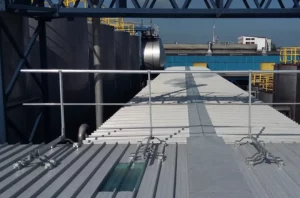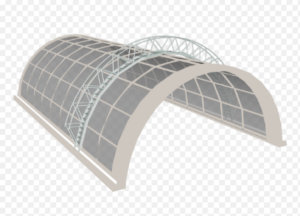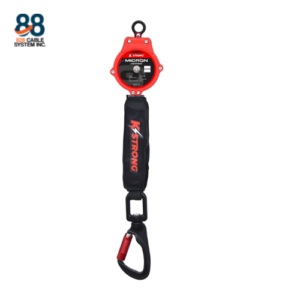
Fall Arrest Lifeline Solutions: Ensuring Safety in the Philippines & Asia
In industries across the Philippines and Asia, ensuring the safety

Worker safety is a paramount concern in industrial settings, where the potential for accidents and injuries can be significant. Among the various safety measures employed, safety guardrail systems stand out as a crucial component in preventing workplace incidents. In this article, we will explore how safety guardrail systems play a pivotal role in ensuring worker safety in the Philippines, shedding light on their importance, regulations, successful implementation, and the benefits they offer.
At its core, a safety guardrail system is designed to provide physical barriers and fall protection, reducing the risk of accidents and injuries in industrial environments. There are different types of safety guardrail systems that are commonly used, including permanent, temporary, and portable guardrails. Permanent guardrails are installed as permanent fixtures to protect workers from falls in high-risk areas. Temporary guardrails are often used during construction or maintenance projects to ensure temporary fall protection. Portable guardrails offer flexibility and can be easily moved to different locations as needed.
The importance of safety guardrail systems cannot be overstated. By creating a physical barrier between workers and hazardous areas, guardrails significantly reduce the risk of falls from heights, slips, trips, and falls on the same level, as well as injuries caused by falling objects. Furthermore, the presence of guardrails instills confidence in workers, fostering a positive work environment and enhancing overall productivity.
The industrial landscape in the Philippines presents unique challenges when it comes to worker safety. In sectors such as construction, manufacturing, and logistics, workers face numerous risks on a daily basis. Falls from heights are a leading cause of workplace injuries, often resulting in severe consequences. Slips, trips, and falls on the same level also pose a significant threat to worker safety. Additionally, falling objects and collisions in high-risk areas further compound the risks faced by workers.
To address these challenges effectively, safety guardrail systems have proven to be instrumental. By providing a physical barrier and fall protection, guardrails mitigate the risk of falls from heights, reducing the likelihood of injuries and fatalities. Moreover, guardrails act as a preventive measure, significantly reducing accidents and enhancing the overall safety culture in the workplace.
In the Philippines, the government has established comprehensive regulations and standards to ensure workplace safety. The Occupational Safety and Health Standards (OSHS) and the Construction Safety and Health Program (CSHP) are two key regulatory frameworks that govern safety practices in various industries. Compliance with these regulations is vital for businesses to maintain a safe working environment.
The regulations encompass various aspects of safety guardrail systems, including design specifications, load-bearing capacity, installation guidelines, and maintenance requirements. By adhering to these regulations, businesses demonstrate their commitment to worker safety and minimize the risk of accidents and injuries.
Several companies and industries in the Philippines have exemplified a strong commitment to worker safety by implementing effective safety guardrail systems. One such case is ABC Construction, which implemented permanent guardrails on their construction sites. The guardrails not only provided fall protection but also instilled confidence in workers, leading to increased productivity and a reduction in accidents.
Similarly, XYZ Manufacturing installed temporary guardrails during their plant expansion project. These guardrails protected workers from falls during construction, contributing to a safe working environment. Testimonials from workers and safety professionals attest to the positive impact of these guardrails on their safety and well-being.
Implementing safety guardrail systems brings a multitude of benefits for businesses and workers alike. Firstly, it significantly improves worker safety by reducing the risk of accidents and injuries. By preventing falls and providing physical barriers, guardrails act as a reliable safeguard, protecting workers from potential hazards.
Secondly, safety guardrail systems enhance worker productivity and morale. When employees feel safe in their work environment, they can focus on their tasks with confidence and peace of mind. This leads to increased productivity, improved job satisfaction, and decreased absenteeism.
Furthermore, investing in safety guardrail systems can result in substantial cost savings for businesses. By preventing accidents and injuries, companies can avoid the financial burden of medical expenses, legal liabilities, and potential downtime caused by workplace incidents.
Lastly, the presence of safety guardrail systems contributes to an overall positive workplace safety culture. When workers witness the commitment to safety from their employers, it fosters a sense of trust and cooperation, encouraging them to follow safety protocols diligently.
Selecting the appropriate safety guardrail system requires careful consideration of various factors. Height requirements and fall distances must be evaluated to ensure the guardrails provide adequate fall protection. Environmental conditions, such as exposure to corrosive elements, may influence the choice of materials for the guardrails. Additionally, the flexibility and portability needs of the work environment should be taken into account to determine the most suitable type of guardrail system.
Engaging safety professionals and consulting reputable suppliers is crucial in making informed decisions regarding safety guardrail systems. These experts possess the necessary knowledge and experience to assess specific work environments and recommend the most effective guardrail solutions.
Ensuring worker safety is a fundamental responsibility for businesses in the Philippines. Safety guardrail systems play an indispensable role in creating a safe working environment, preventing accidents, and protecting lives. By adhering to regulations, implementing guardrails effectively, and choosing the right system for specific work environments, businesses can prioritize worker safety and reap the benefits of increased productivity, reduced costs, and a positive safety culture. Let us join hands in safeguarding lives and making workplaces in the Philippines safer for everyone.

In industries across the Philippines and Asia, ensuring the safety

In today’s architecture and urban planning, greening solutions play a

In today’s fast-paced world of construction and maintenance, efficient access

In industries where working at heights is commonplace, ensuring the

In workplaces where heights are involved, ensuring safety against falls

In the realm of modern architecture, the integration of innovative
Copyright © 828 Cable System Inc. Philippines 2023 All Right Reserved